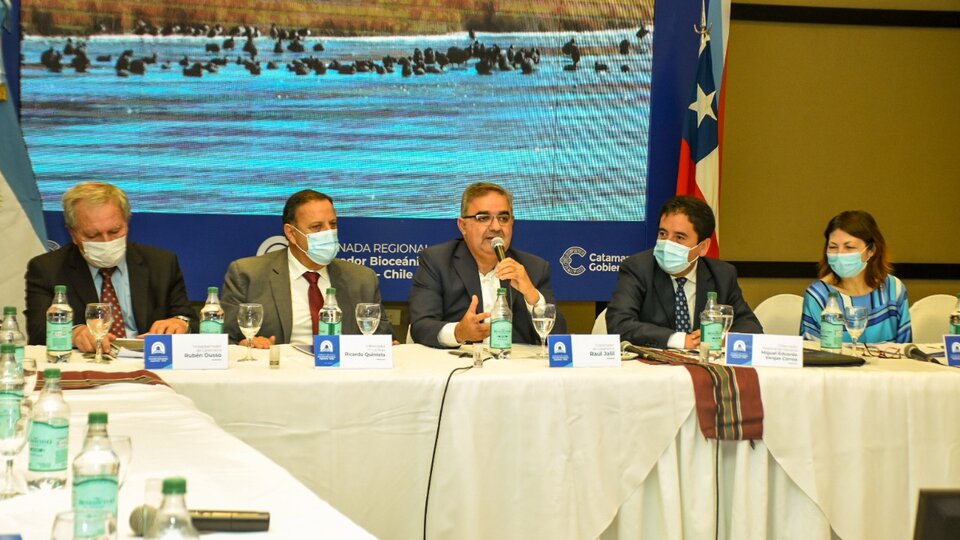The first day of the ATACALAR binational meeting between Argentina and Chile, was highlighted by the presentation of the study carried out on site by the FADEEAC (Argentine Federation of Business Entities of Freight Transportation). The report revealed the advantages that transportation will have through the Paso de San Francisco (Catamarca) and Pircas Negras in the province of La Rioja.
This analysis revealed that the two priority steps are the step of Cristo Redentor, in Mendoza, and Jama, in Jujuy. “What we have to look for now is to have strategic steps, there are 1,500 km between Jama and Cristo Redentor, and in the middle we have a critical mass of the country, which is the productive country that necessarily has to move up or down, in this At the moment we have an opportunity that are the ports that are in this region on the Chilean side (Atacama), being able to take advantage of them and make a direct step will be fundamental “, he explained Carlos Garcia Gutierrez, one of those responsible for the FADEEAC study.
In this sense, the study revealed that there are more volumes of cargo leaving the country by land than through ports. The main clients are Chile and Brazil, to a lesser extent Uruguay and Paraguay. But at the same time a lot of loads that go to Asia They leave through the ports of Chile and Brazil, which means that the loading of containers and bulk trucks via land is more intensive than through our own ports that we have in the country on the Atlantic.
“This detail focuses us on where we have to make the investments, towards the border posts and speed up the crossing of the borders. In this context, a two-way corridor was analyzed, because we are a country that greatly benefits from having access to the Atlantic and the Pacific, which implies an industrial integration, that the countries associate and give it added value and according to the convenience of the customer can leave one way or the other, “said García Gutiérrez.
In this context, the governor of La Rioja, Ricardo Quintela explained that they are seeking to do joint work with Catamarca, “although they have their step, that of San Francisco that is consolidating and this will favor the region and open the doors to East”.
Mining activity
Another of the fundamental points of the analysis was the country’s mining activity. The importance of the activity for the Atacama region and the different regions of Argentina was raised, and a map with data obtained from the National Geographic Institute was presented.
“In the case of Catamarca we can see what is the output of minerals from the country, what goes out to the foreign market and what is from the domestic market, highlighting gold, silver, copper and now lithium appears as the main actor to have in bill. Although so far the export is raw, there is already information on how it is being processed in Brazil. That is to say It leaves our mines and Chile to later become batteries in Brazil to go to China and then return to Argentina as electric cars. What we see is a very generous opportunity to convert that lithium into batteries and export it from our territory ”, García Gutiérrez analyzed.
On the other hand, the agricultural production of the entire country was also analyzed with an increase since 2013 of 40% without counting soybeans, “we show these values so that we take into account that there are other products and there are other opportunities that are the critical mass and we can see the possibility of expanding the agricultural frontier of other products that are not grown simply because logistics are more expensive to take it to traditional ports. When we find a port on the other side, we are putting the axis in being able to generate new frontiers ”, he clarified.
Agreement with China
One of the main promoters of the Corridor in the last two government administrations, has been the deputy governor of Catamarca Ruben Dusso. During yesterday’s session, Dusso highlighted the work he has been doing with Chinese investors and explained that a representative of the Chinese government for the region is participating in the activities: “negotiations are available for him. It was also clarified by the Argentine ambassador to China, who already communicated that the Asian Infrastructure Investment Bank he already knows the project and offered the financing ”, he assured.
“We were never so close to completing this project, Silvina (Batakis) was suggesting the creation of a unit that deals exclusively with the Corridor, because that way the work between the ministries is unified,” said Dusso, consulted by Catamarca/12.
The sessions are headed by the governor of Catamarca, Raúl Jalil, the one from the Atacama Region, Miguel Vargas Correa, the one from La Rioja, Ricardo Quintela, the Secretary of the Province of the Ministry of the Interior, Silvina Batakis, and the Deputy Governor of Catamarca Rubén Dusso.
Today the entourage will move to Tinogasta to visit productive enterprises such as the recently created Mostera, where must is concentrated, one of the main products that is sought to be exported through the San Francisco Pass to Asia. Then the entourage will move to Fiambalá, a municipality that borders Chile, to inaugurate the mini-hospital tomorrow in the border area of The Grottoes. The Minister of Health of the Nation will participate in the inauguration Carla Vizzotti.
Related notes: https://www.pagina12.com.ar/383476-encuentro-binacional-por-el-corredor-ferroviario-bioceanico
– .


